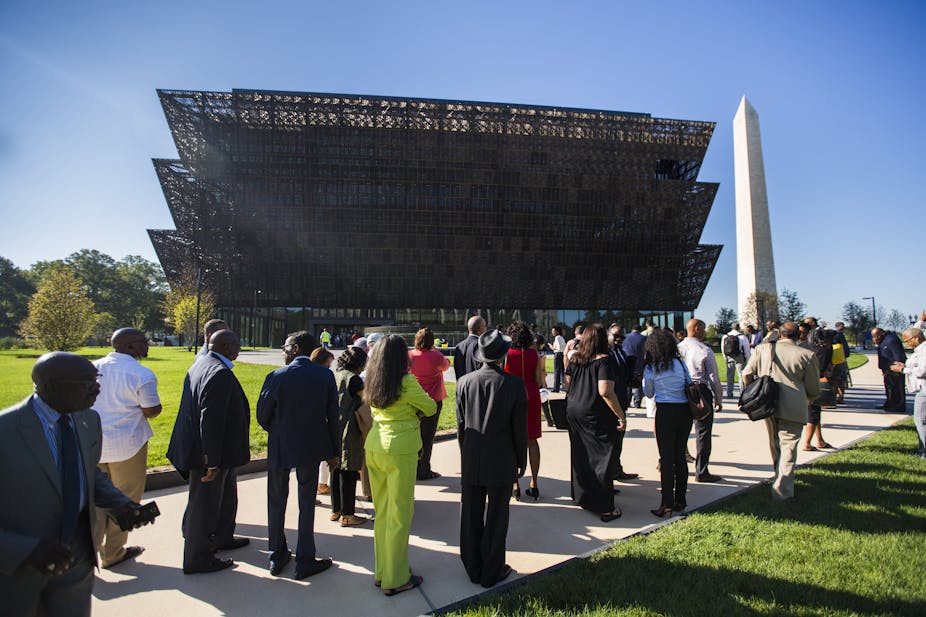Just before the US presidential election, Kenya Barris, creator of the sitcom black-ish, derided Donald Trump as “a rich, tall, white man who says he’s going to make America great again … a cupcake a lot of people would buy”. By the time he’s inaugurated as president, the US’s National Museum of African American History and Culture will have been open for four months.
The museum is an upturned pyramid running parallel with the Washington Monument, like two uplifted arms in praise. Timed day-tickets go online at 6.30am, and sell out by 10am. On a visit to Washington just before inauguration week, I spoke to receptionist Demetrius as he prepared to welcome visitors; in private, he told me, he’s praying for himself and America, and carefully choosing which guests he will implore to pray too.
The museum’s “Culture” section is above ground – bright, reaching up to the light. Its “roots”, noted Obama, when he opened the museum, spread “far wider and deeper than any tree on this Mall” into the the underground “History” section. Crowds are ushered into a lift that descends 70 feet below, past inscriptions of key dates in the black American story, counting backwards from today to 1450.
Looping and zig-zagging around and between the museum’s floors, one can see both ahead and behind, experiencing the “Yes, we can” mentality, whether enslaved or free. Intellect comprehended, reflected and projected America; skilled craft labour designed it, and menial, unskilled labour built it. This is not a linear history, but an attempt to represent the African-American experience, past and present: Black Power, next to Harriet Tubman’s shawl, beside a sugar-pan and a field whip (“Gift of Oprah Winfrey”).
On the top floor of the museum, the art gallery is a series of angular rooms. Guyanese-born Donald Locke whose Plantation, created in the 1970s, is a series of linked sculptures to illustrate an oppressive system, in which brown and black ceramic shapes are fixed and held down in luxury fabrics. His estate has donated Landscape with Kwame N’Krumah, celebrating the election of Ghana’s first independent leader. Towering over the main entrance space is Chakaia Booker’s 2016 Liquidity of Legacy, creating “all the beauty of survival and success” from the discard of urban grime.

The “Culture” space features concentric circles of display cabinets. In the centre is a caryatid by the Yoruban artist Olowe of Ise, whose corona of three tiers gives the museum its outline against the sky. It is cradled by a case of Philip Simmons’ Charleston ironwork, which is the inspiration for its latticed carapace. Emphasising heritage recorded in food culture, movement, style, activism and community, the gallery knits past and present into a four-minute montage of sound, image, quotations and film, guiding visitors in a circular path around the outer wall.
The “People resist by telling their story” (bell hooks); “Songs of liberation – who can lock them up?” (Paul Robeson); the sound of rhythm beaten out by basketballs.
Into the wind
Two weeks to go till Trump takes office, I met a cab driver, Elias. As Obama himself is sometimes described he’s an African and an American but not an African-American, the descendant of immigrants rather than slaves. He is Trump’s nightmare: immigrant, autodidact – citing Thomas Jefferson, Karl Marx, and Aldous Huxley in the space of one and a half miles – and proud socialist. As far as he’s concerned, Trump, Hillary Clinton and even Bernie Sanders are all corrupt. (The only politician of principle he named was Jeremy Corbyn.)
Just up the Potomac River in Virginia, the little town of Ashburn and Anita’s Restaurant, named after its immigrant founder, has made national news. Waitress Kelly Carter had received a note from a white couple, written at the bottom of their bill: “Great service don’t tip black people.” Staff and regulars are rallying behind her to prove racist America wrong – even as the election “seems to have created an atmosphere where people can behave that way”.
Resistance to racism was palpable. On January 9, to pre-empt the incoming president’s deportation plans, Washington’s Mayor, Muriel Bowser, headed to Gallaudet University to launch a bid to join other liberal locations in becoming a “sanctuary city”. US$500,000 is pledged to help immigrants turn their green cards into citizenship and cover the costs of deportation hearings.
Meanwhile, the latest edition of Ebony magazine hit the newsstands, its cover bearing a black version of Grant Wood’s ubiquitous painting American Gothic, with a black child holding a Stars and Stripes rather than a hay-fork. “Yes, we still can: How the black community will save itself”.

